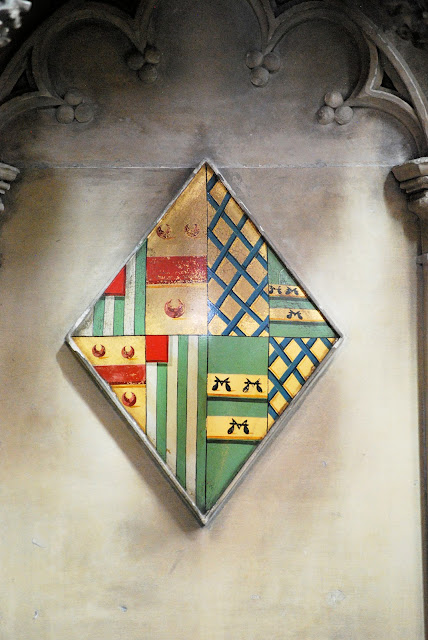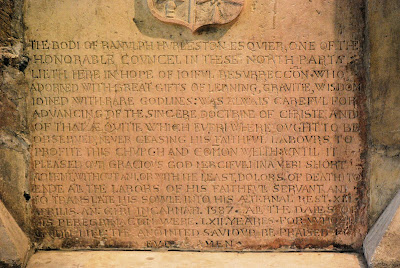The short marriage of the husband and wife who are commemorated in our next memorial remind me of a line from Act I, Scene II, of Shakespeare's Richard III: "I'll have her, but I will not keep her long."
This memorial is that of a married couple who didn't have many years together: he died at 25, while she lived to 73.
The inscription reads:
The inscription reads:
Sacred
to the memory of the
Revd Geo. Wm. Anderson,
who departed this life
on the 16th day of April,
in the Year of Our Lord 1785,
and in the 25th year of his age.
Also
to his widow
Lucy Anderson,
who afer an exemplary life
of unaffected piety,
and active benevolence,
died at Harrowgate
on the 20th of Septr 1830,
aged 73 years.
The memory of the just
is blessed.
George W. Anderson's wife was Lucy Moore, and the arms painted on the memorial show Anderson impaling Moore.
The husband's arms are a variant and cadet of “Anderson (Penley, co. Herts, bart., created 1643; extinct 1899; the heiress, Elizabeth Anderon, m. Simon Harcourt, Esq. Clerk of the Crown). Argent a chevron between three crosses crosslet (another, three crosses formy) sable. Crest—A water spaniel passant or (from Burke's General Armory).
The husband's arms are a variant and cadet of “Anderson (Penley, co. Herts, bart., created 1643; extinct 1899; the heiress, Elizabeth Anderon, m. Simon Harcourt, Esq. Clerk of the Crown). Argent a chevron between three crosses crosslet (another, three crosses formy) sable. Crest—A water spaniel passant or (from Burke's General Armory).
Here the crosses are fleury, and there is a crescent for difference in chief.
The wife's arms are Moore: Azure on a chevron between three lion’s heads erased or three martlets sable (also from Burke's).
The wife's arms are Moore: Azure on a chevron between three lion’s heads erased or three martlets sable (also from Burke's).
The memorial is done without extravagance, and the arms and crest painted simply within a moderately ornate frame. All in all, a fitting memorial to a couple who didn't have many years together.






































